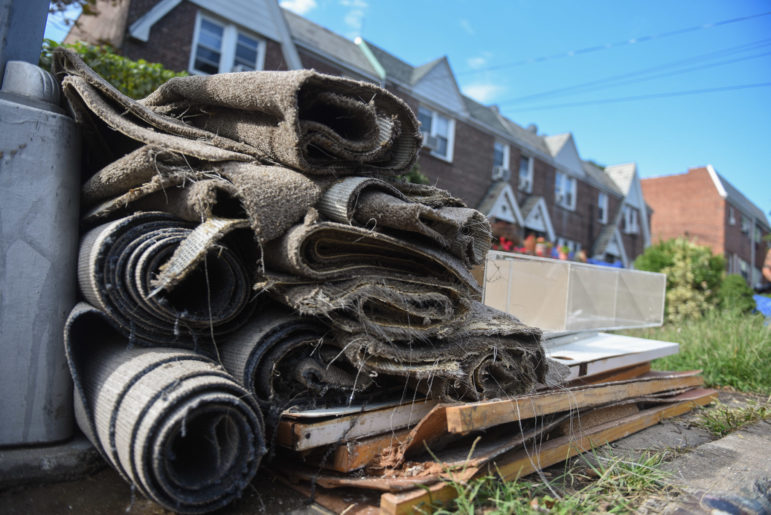Just three acres in Central Queens are designed to handle stormwater runoff, but to more effectively prevent flooding, the area would need about 120 acres of green infrastructure, the report found.

Michael Appleton/Mayoral Photography Office
Flood damage in Woodside, Queens, following Hurricane Ida in 2021.Nearly a year after Hurricane Ida floodwaters killed 11 New Yorkers inside basement apartments, the Regional Plan Association (RPA) is calling on the city to pursue a number of steps to reduce rainfall risk—like turning parking spots into absorbent garden plots to capture runoff.
The planning nonprofit’s report, “Preventing Another Ida,” honed in on the Central Queens neighborhoods of Jackson Heights, Woodside, Elmhurst, Corona and Rego Park, where there are more than 40,000 buildings with basement units, many of them rented out to immigrant New Yorkers.
Of the 11 New York City residents who drowned in basement apartments during Ida, 10 lived Queens, including three in Woodside, one in Elmhurst and another in Corona. Across the five boroughs, unregulated basement units provide a vital—though usually illegal—source of housing, with more than 100,000 New Yorkers living in unauthorized underground homes, according to city estimates.
RPA Senior Planner Marcel Negret, one of the authors of the report, led a tour of the Corona area and pointed out the problems that lead to extreme stormwater runoff as well as possible solutions to reduce flooding.
“We picked this geography given the concentration of fatalities and the flood loss that occurred during Ida,” Negret said. He showed reporters a curbside garden designed to absorb rainwater, a vacant lot where he urged the city to develop green infrastructure and Corona Golf Playground, where a subsurface detention system—designed to temporarily store stormwater runoff underground—is in the design phase. At Corona Plaza, Negret highlighted what he called a missed opportunity to improve stormwater management across the large swath of pavement.
The RPA report recommends lining local roadways with green infrastructure, like absorbent rain gardens and permeable pavement. Just three acres in Central Queens are designed to handle stormwater runoff, but to more effectively prevent flooding, the area would need about 120 acres of green infrastructure, the report found.
“We need to start viewing extreme weather events not only as climate change issues, but also as public health crises that most severely impact low-income communities,” said RPA President and CEO Tom Wright in a statement.

Daniel Parra
RPA’s Marcel Negret next to the Corona Golf Playground, one of the sites where the city is planning stormwater mitigation measures.
The report also urges state lawmakers to legalize accessory dwelling units—extra apartments, like basement units, beyond what local zoning rules allow. That regulatory relief would make it easier for New York City residents to bring existing basement apartments out of the shadows and up to code. That means installing a second means of egress, waterproof walls and seven-foot ceiling, according to city rules.
With the Sept. 1 anniversary of Ida fast approaching, it remains unclear if a single basement apartment has been brought up to code and legalized in the last 11 months. The city’s Department of Housing Preservation and Development (HPD) did not provide a figure when contacted July 12 and again Monday.
A 2019 pilot program to help homeowners legalize basement apartments had its budget slashed a year later as COVID-19 and other economic factors strained city finances. Construction is finally set to begin on the first six basement apartments included in the East New York Basements Pilot this fall, said program director Ryan Chavez of the Cypress Hills Local Development Corporation.
Chavez attributed the delays to high costs, onerous administrative requirements and “a very, very challenging approval process” through the Department of Buildings.
He said he doubted any property owners outside the pilot program have begun work on legally converting their basement units because of the high costs. He estimated that the construction and approval process would run about $250,000 per unit, mostly because property owners have to bring their entire buildings up to code—not just the basements.
Mayor Eric Adams’ housing plan references the pilot program in East New York, calling it “a testing ground for potential strategies to facilitate policies and programs for basement conversions citywide.” Yet to bring conversions to scale—or at least into the double digits—the city will need the state to act, the plan notes.
In the absence of state policy to more easily legalize basement apartments, the city has developed an alert system for heavy rains and spearheaded awareness campaigns that warn residents of the dangers of staying in their units during storms. The housing plan suggests tapping informal networks to spread the word about incoming storms, including Los Deliveristas and app-based delivery services.
Adams has also said his administration would commence a basement apartment census—something his predecessor Bill de Blasio pledged to do in the wake of Ida’s devastation. But that’s no easy task when owners and renters are wary of reporting illegal conditions.
In the meantime, Chavez said, renters and owners are on their own to make their vital, but still illegal, basement units safer.
“It’s sort of the Wild West when it comes to basement apartments,” he said. “And the city and state have not stepped up to bring any order to this.”










One thought on “Green Design Could Prevent Ida-Style Flooding in 40K Queens Basements: Report ”
It seems there are many workable solutions to the problems that could also secure safe housing for those who have not many choices of where they can afford to live. The bottom line here to actualizing the solutions discussed are mostly dependent on dollars, real monies.
Money was so available to supporting the Buffalo Bills already rich franchise. Perhaps that should be considered when saying no monies are available to assist the communities in need of protection from the climate-induced risks to life here in the City. Where there is a will to do something, it can be done. The question always comes down to who has the will and the dollars.???
?